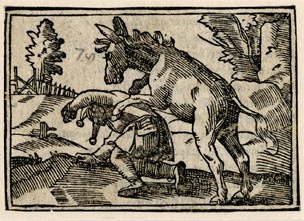Recently a commentator on The Daily Show referred to the Republican candidates as "a Noah's Arc of Idiots..."
 |
| The Ship of Fools | Hieronymus Bosch c.1510-15 | Louvre Museum Inspired by the book: |
 |
| Ship of Fools by Jake Baddeley, 2009. |
 |
| Woodcut attributed to Haintz-Nar-Meister. | Illustration from Stultifera navis (Ship of Fools) by Sebastian Brant, 1498. University of Houston Digital Libraries |
HOLY FOOLS
"Versatile rationality and obscene sensuality belong essentially together, because they are both taboo-breaking assaults on some hierarchical mythological order," (Zucker 311).
The Jester is almost always depicted carrying a staff, a phallic symbol also linking him to Mercury, the winged messenger of the gods.
|
Hermes | Artist Unknown | from jrfibonacci.wordpress.com
 |
| Jester's Staff, Bronze,15th c. | British Museum Collections
|
In Christian thought:
"The devil as clown is the antagonist of the whole cosmic order. But...he himself is part of that order... The ridiculous presupposes the sublime, and the sublime in princely graciousness permits the presence of the ridiculous." (Zucker 312).
Social discourse also displays... built-in devices of criticism, of rebellion, of protest against existing structures, against boundaries, against the seriousness of order; and these devices are socially and ritually acknowledged. They are manifestations of the chaos on which order depends and over which it must reign supreme. The other paradox of inverted social action, of chaotic topsy-turvydom, is that it remains a beacon pointed toward the positive, for with its constant attempt to create an antistructure, it cannot avoid structure or even deny it because, without it, chaos would not be possible. Such social figures of antistructure, which surpass the boundaries of the controlled, irreversible, perfect delineation of the world we find in the clown and the transvestite and in customs like the backward acting and reversing of speech at festive occasions (Koepping 193).
PROFESSIONAL FOOLS
"The vogue of the court fool seemed to have steadily increased during the fourteenth and to have culminated in the fifteenth and in the early sixteenth century, when he became a highly significant figure not only in social life, but still more in art and literature..." (Welsford 116) though there is evidence of court fools employed in Europe as early as the 12th century, and elsewhere long before.Welsford writes that there is meagre evidence on the lives of court-fools, but that we can tell they were fed and clothed, received pay and medical treatment, and "were honorably buried," (119). This suggests a very different life and opinion of them than other performers received, who were traditionally vilified or looked down upon in ways equivalent to prostitutes.
In her widely referenced book, The Fool: His Social and Literary History, she writes of the fifteenth century, "Fools were employed by corporations as well as kings and noblemen... not excluding taverns and brothels." Professional Fools, amateur actors in Fool-Societies, and village idiots were coded by dress to mark them as fools. Court fools may have usually dressed as normal courtiers, while amateurs wore the recognizable motley, bells, hoods with ears, coxcombs and even tails. They carried bladders, swords or staffs." It has been pointed out that the fool thus adorned is not unlike the animal-mummers who... are usually supposed to be connected with religious ritual," (123).
Natural Fool vs. The Artificial Fool
- both employed at the professional level.
- The "natural" fool is the deformed, mentally-handicapped or otherwise "other."
- The artificial fool is an especially witty or acrobatic individual who worked more or less as a professional actor.
 |
| Fool |Mid-16th C., Painter Unknown.| Flemish | Wellesley College |
 |
| From a series of four engravings by Franz Isaac Brun, 1555-1610. | British Museum Collections |
 |
| From a series of four engravings by Franz Isaac Brun, 1555-1610 | British Museum |
 |
| Costume study for a female fool | Circle School of Stefano dell Bella 1625-1664| British Museum |
 |
| Costume study for a fool | Drawn by Stefano della Bella 1625-1664.| British Museum |




No comments:
Post a Comment